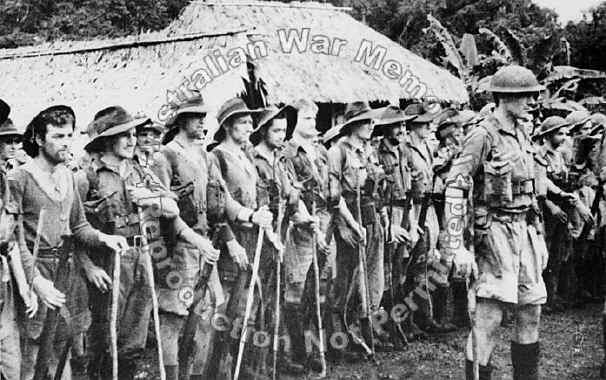 |
|
|||
|
|
||||
|
39th Infantry Battalion |
|
-An Australian Militia Battalion - This article is based on, and largely reproduced from "To Kokoda and Beyond" by Victor Austin, (of 39 Bn and later 2/2 Bn AIF); Volume V of "Australia in the War of 1939-45" by Dudley McCarthy; "Pacific Victory" by Hugh Buggy; and "Recollections of a Regimental Medical Officer" by H D Steward.
The untried, and largely untrained, 'garrison battalion' found itself in Port Moresby in the front line of Australia's defence, just weeks after the Japanese attack on Pearl Harbour and a devastating series of reverses in the Pacific and Asian theatres of the war. Sent to the Owen Stanleys this small force from 24 July was faced by a selected Japanese invasion force estimated at 1500 men, reinforced by another 3000 landed at Gona on 13 August, and it was not until 26 August that the first elements of the 7th Division became involved in the battle. (Although 53 Bn was in the battle area from 24 July, they had landed at Moresby in January "badly trained, ill disciplined and generally resentful" and proved to be "below standard required for action" (Brig Potts) and were withdrawn).
Their faces had no expression, their eyes sunk back into their sockets. They were drained by malaria, dysentery, and near-starvation, but they were still in the firing line, facing a much more powerful enemy with much heavier weaponry." Hugh Buggy summed up the position, thus, "Battalion and Brigade officers spoke in the highest terms of the deeds of the men of the 39th Militia Battalion, to whom fell the almost superhuman task of delaying numerically superior Japanese forces, who were supplied along the short and easier line from Buna to Kokoda." Resting at Koitaki, the 39th received reinforcements; 100 from the 53rd Bn (by then disbanded) and later, 300 from Australia. On 30 Nov the Battalion was again in action, in the Gona-Sanananda area in which it suffered more casualties than in the Owen Stanleys. In the period 3 - 18 December losses were 8 officers and 220 men killed and wounded. By January 1943 when Sanananda fell, battle casualties and medical evacuations had reduced the Battalion to platoon strength - 32 all ranks. The reason for Army Command's decision to strike the 39th Battalion from the Order of Battle will probably always be a mystery and one which seems now, and which surely should have been apparent then, to have been a major injustice. This occurred on 3 July 1943. |
| My Name is Frank Dickie although for reasons which are not relevant here I am known as Frank Killeen. One of my brothers Pte. William Dickie was on Active Service with the 39th. from 4/1/1942 to 28/2/1943. He was discharged Medically Unfit ( Malaria) later on lost his legs after being run over by a train and died on 27th.February 1973. He is buried in Mooroopna Vic. Cemetery. I used to see Billy quite a bit before his Death and I have some Photos and his war record etc. I am the sole survivor of the Dickie Family and I thought that if there is any sort of 39th.Battallion Association I would like them to know that Billy had a Brother called Frank, that he is still alive and that he would be interested to hear from them at any time. I can tell you something interesting about Billy's Grave. Every Remembrance Day someone puts a Poppy on his Grave...every year. And no one has ever been able to find out who does it! Kind Regards, Frank Killeen |



